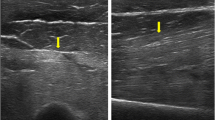Abstract
This review illustrates the imaging features of rhabdomyolysis across multiple modalities and in a variety of clinical scenarios. Rhabdomyolysis is the rapid breakdown of striated muscle following severe or prolonged insult resulting in the release of myocyte constituents into circulation. In turn, patients develop characteristically elevated serum creatine kinase, positive urine myoglobin, and other serum and urine laboratory derangements. While there is a spectrum of clinical symptoms, the classic presentation has been described as muscular pain, weakness, and dark urine. This triad, however, is only seen in about 10% of patients. Thus, when there is a high clinical suspicion, imaging can be valuable in evaluating the extent of muscular involvement, subsequent complications such as myonecrosis and muscular atrophy, and other etiologies or concurrent injuries causing musculoskeletal swelling and pain, especially in the setting of trauma. Sequela of rhabdomyolysis can be limb or life-threatening including compartment syndrome, renal failure, and disseminated intravascular coagulation. MRI, CT, ultrasound, and 18-FDG PET/CT are useful modalities in the evaluation of rhabdomyolysis.








Similar content being viewed by others
References
Giannoglou GD, Chatzizisis YS, Misirli G. The syndrome of rhabdomyolysis: Pathophysiology and diagnosis. Eur J Intern Med. 2007;18(2):90–100.
Torres PA, Helmstetter JA, Kaye AM, Kaye AD. Rhabdomyolysis: pathogenesis, diagnosis, and treatment. Ochsner J. 2015;15(1):58–69.
Omar IM, Weaver JS, Samet JD, Serhal AM, Mar WA, Taljanovic MS. Musculoskeletal manifestations of COVID-19: currently described clinical symptoms and multimodality imaging findings. Radiographics. 2022;42(5):1415–32.
Moratalla MB, Braun P, Fornas GM. Importance of MRI in the diagnosis and treatment of rhabdomyolysis. Eur J Radiol. 2008;65(2):311–5.
Flores DV, Mejia Gomez C, Estrada-Castrillon M, Smitaman E, Pathria MN. MR Imaging of muscle trauma: anatomy, biomechanics, pathophysiology, and imaging appearance. Radiographics. 2018;38(1):124–48.
Bosch X, Poch E, Grau JM. Rhabdomyolysis and acute kidney injury. N Engl J Med. 2009;361(1):62–72.
Kim JH, Kim YJ, Koh SH, Kim BS, Choi SY, Cho SE, et al. Rhabdomyolysis revisited: Detailed analysis of magnetic resonance imaging findings and their correlation with peripheral neuropathy. Medicine. 2018;97(33):e11848.
Ejikeme C, Alyacoub R, Elkattawy S, Shankar T, Yuridullah R. A rare complication of rhabdomyolysis: peripheral neuropathy. Cureus. 2021;13(3):e14202.
Lamminen AE, Hekali PE, Tiula E, Suramo I, Korhola OA. Acute rhabdomyolysis: evaluation with magnetic resonance imaging compared with computed tomography and ultrasonography. Br J Radiol. 1989;62(736):326–30.
Lu CH, Tsang YM, Yu CW, Wu MZ, Hsu CY, Shih TT. Rhabdomyolysis: magnetic resonance imaging and computed tomography findings. J Comput Assist Tomogr. 2007;31(3):368–74.
May DA, Disler DG, Jones EA, Balkissoon AA, Manaster BJ. Abnormal signal intensity in skeletal muscle at MR imaging: patterns, pearls, and pitfalls. Radiographics. 2000;20:S295–315.
Smitaman E, Flores DV, Gómez CM, Pathria MN. MR imaging of atraumatic muscle disorders. RadioGraphics. 2018;38(2):500–22.
Wasserman PL, Way A, Baig S, Gopireddy DR. MRI of myositis and other urgent muscle-related disorders. Emerg Radiol. 2021;28(2):409–21.
Barloon TJ, Zachar CK, Harkens KL, Honda H. Rhabdomyolysis: computed tomography findings. J Comput Tomogr. 1988;12(3):193–5.
Kaplan GN. Ultrasonic appearance of rhabdomyolysis. AJR Am J Roentgenol. 1980;134(2):375–7.
Steeds RP, Alexander PJ, Muthusamy R, Bradley M. Sonography in the diagnosis of rhabdomyolysis. J Clin Ultrasound. 1999;27(9):531–3.
Su BH, Qiu L, Fu P, Luo Y, Tao Y, Peng YL. Ultrasonic appearance of rhabdomyolysis in patients with crush injury in the Wenchuan earthquake. Chin Med J (Engl). 2009;122(16):1872–6.
McMahon CJ, Wu JS, Eisenberg RL. Muscle edema. AJR Am J Roentgenol. 2010;194(4):W284–92.
Cheung K, Hume P, Maxwell L. Delayed onset muscle soreness: treatment strategies and performance factors. Sports Med. 2003;33(2):145–64.
Liu PT, Ilaslan H. Unicompartmental muscle edema: an early sign of deep venous thrombosis. Skeletal Radiol. 2003;32(1):41–5.
Author information
Authors and Affiliations
Corresponding author
Ethics declarations
All applicable international, national, and/or institutional guidelines for the care and use of animals were followed.
Consent to participate
Approval from the Institutional Review Board was obtained and in keeping with the policies for a retrospective review, informed consent was not required.
Conflict of interest
The authors declare no competing interests.
Additional information
Publisher’s note
Springer Nature remains neutral with regard to jurisdictional claims in published maps and institutional affiliations.
Rights and permissions
Springer Nature or its licensor (e.g. a society or other partner) holds exclusive rights to this article under a publishing agreement with the author(s) or other rightsholder(s); author self-archiving of the accepted manuscript version of this article is solely governed by the terms of such publishing agreement and applicable law.
About this article
Cite this article
Rixey, A.B., Glazebrook, K.N., Powell, G.M. et al. Rhabdomyolysis: a review of imaging features across modalities. Skeletal Radiol 53, 19–27 (2024). https://doi.org/10.1007/s00256-023-04378-5
Received:
Revised:
Accepted:
Published:
Issue Date:
DOI: https://doi.org/10.1007/s00256-023-04378-5




